Greenpoint Snail (Trachycystis rariplicata)
The Greenpoint Snail, described in 1849, is known exclusively from Green Point, today a suburb of Cape Town, South Africa.
This species is now extinct, and its extinction is sometimes attributed to the introduction of an invasive Mediterranean snail species, the Mediterranean Coastal Snail (Theba pisana (Müller)), which is now very abundant in that region. However, the true reasons for its disappearance are rather found in the massive habitat destruction by swamp drainage, building of sports fields, houses and other extensive transformations.
***
syn. Helix rariplicata Pfeiffer, Pella rariplicata (Pfeiffer)
*********************
edited: 22.08.2022
Tag Archives: South Africa
Lampranthus vanzijliae (L. Bolus) N. E. Br.
Worcester Brightfig (Lampranthus vanzijliae)
The Worcester Brightfig, described in 1930, is known only from a single locality in the Worcester District in the Southwestern Cape Province of South Africa.
The species disappeared around 1921 due to habitat loss caused by agriculture and urbanization.
***
syn. Mesembryanthemum vanzijliae L. Bolus
***
The photo below shows a congeneric taxon that occurs more or less in the same locality, the Runty Brightfig (Lampranthus debilis (Haw.) N. E. Br.).
*********************
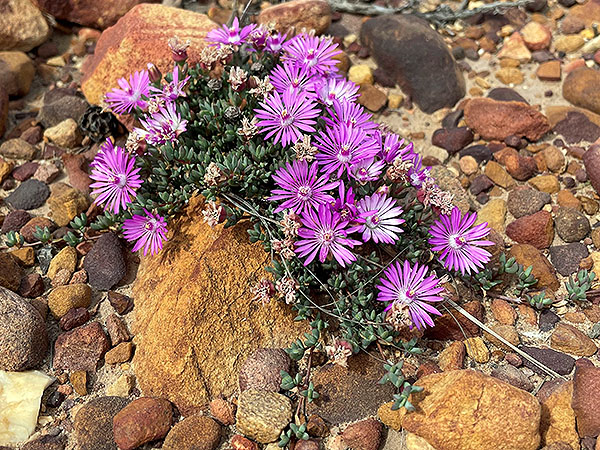
Photo: markberry
https://www.inaturalist.org/people/markberry
https://creativecommons.org/licenses/by-nc/4.0/
*********************
edited: 21.08.2022
Acrotylus mossambicus Brancsik
South-East African Burrowing Grasshopper (Acrotylus mossambicus)
The South-East African Burrowing Grasshopper was described in 1893, it apparently is widely distributed over parts of Mozambique, South Africa, Tanzania and Zimbabwe.
The species has apparently not been recorded since 1946 and might be extinct, however, given its wide distribution this assumption seems quite strange.
*********************
edited: 03.11.2020
Nemesia micrantha Hiern
This species is known only from the type material that was collected in 1897; it was restricted to a single site that was described as pools near a fish factory at the Hout Bay on the Cape Peninsula in Western Cape, South Africa.
The species is now extinct.
*********************
References:
[1] N. A. Helme; T. H. Trinder-Smith: The endemic flora of the cape Peninsula, South africa. South African Journal of Botany 72: 205-210. 2005
*********************
edited: 27.04.2022
Phylica schlechteri Pillans
Orangekloof Hardleaf (Phylica schlechteri)
Thia species was restricted to a very small area along the southwestern coast of the Western Cape Province of South Africa, where it was found growing in so-called sandstone fynbos.
The species has not been found since over 100 years and is very probably extinct. [1]
*********************
References:
[1] N. A. Helme; T. H. Trinder-Smith: The endemic flora of the cape Peninsula, South africa. South African Journal of Botany 72: 205-210. 2005
*********************
edited: 04.11.2020
Eugenia pusilla N. E. Br.
Small Eugenia (Eugenia pusilla)
The Small Eugenia, described in 1912, was restricted to the province of Mpumalanga in South Africa.
The species was last seen in 1920, it was never found again since and is most likely extinct now.
*********************
edited: 18.01.2020
Heliophila tabularis Wolley-Dod
This species was restricted to the Sandstone Fynbos of the Cape Peninsula of the Western Cape Province, South Africa; it was last seen in 1970 and might be extinct now.
*********************
edited: 02.05.2022
Vernonella africana Sond.
African Vernonella (Vernonella africana)
The African Vernonella inhabited a quite small area of coastal grassland along the eastern coast of KwaZulu-Natal in South Africa which tioday is almost entirely transformed by agriculture and urban development.
This species was last found in 1895 and is now considered extinct.
********************
edited: 02.10.2020
Allocotocerus mixtus (Orchymont)
Table Mountain Water Scavenger Beetle (Allocotocerus mixtus)
The Table Mountain Water Scavenger Beetle was described in 1939; the species was endemic to the Table Mountain next to Cape Town in the Western Cape Province of South Africa.
The species has never been found since and is likely extinct now. [1]
***
The species is often found under the name of Allocotocerus mistus (Orchymont) containing a typo.
*********************
References:
[1] A. G. Rebelo; P. M. Holmes; C. Dorse; J. Wood: Impacts of urbanization in a biodiversity hotspot: Conservation challenges in Metropolitan Cape Town. South African Journal of Botany 77: 20-35. 2011
*********************
edited: 16.02.2024
Cephalophyllum parvulum (Schltr.) H. E. K. Hartmann
Small Ice Plant (Cephalophyllum parvulum)
This species was restricted to the Fynbos in the clanwilliam area in the Western Cape Province of South Africa; most of the this region has been developed for urban or agricultural use.
The Small Ice Plant is now considered extinct.
*********************
edited: 01.11.2020
Barleria natalensis Lindau
The Natal Barleria is known only from the type material that was collected in 1890 at Verulam, a small town in KwaZulu-Natal, South Africa.
The type locality has been completely transformed to commercial sugarcane cultivation; the plant has not been found since the type collection and is most likely extinct now.
*********************
edited: 16.05.2022
Trimenia malagrida ssp. malagrida (Wallengren)
The Scarce Mountain Copper is a little butterfly species with at least four subspecies that occur in some regions of South Africa; the nominate form from the Cape Peninsula is thought to be extinct.
The last known population that was known to exist in the late 1980s inhabited an extremely small area and counted only some 20 to 50 individuals; they apparently disappeared due to forest fires that occurred too often and got out of control.
The photo below shows an individual from another subspecies, the Cederberg Scarce Mountain Copper (Trimenia malagrida ssp. cedrusmontana (Dickson & Stephen)).
*********************
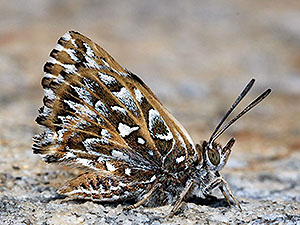
Cederberg Scarce Mountain Copper (Trimenia malagrida ssp. cedrusmontana)
Photo: Brian du Preez
https://www.inaturalist.org/people/mr_fab
https://creativecommons.org/licenses/by-sa/4.0/
*********************
edited: 21.08.2022
Erica velitaris Salisb.
Armed Heath (Erica velitaris)
The Armed Heath is one of numerous heath species that are endemic to the Western Cape Province of South Africa, its taxonomic status is not fully clearified and it may in fact be a hybrid, however, there are two additional varieties that sometimes are accepted, Erica velitaris var. hemisphaerica Bolus, and Erica velitaris var. parvibracteata Bolus.
If this is in fact a true species with three subspecies, then the nominate may be extinct.
*********************
References:
[1] N. A. Helme; T. H. Trinder-Smith: The endemic flora of the Cape Peninsula, South africa. South African Journal of Botany 72: 205-210. 2005
*********************
edited: 18.05.2019
Hippotragus leucophaeus (Pallas)
The Bluebuck was described in 1766; during the Late Pleistocene, the species was very widespread in South Africa, but the populations began to shrink following climatical changes at the beginning of the Holocene, in historical times, the species was finally restricted to a relict population that inhabited a rather small region at the southern tip of South Africa.
The species had a generally bluish gray fur, the upper lip and a patch in front of the eye were somewhat lighter, the forehead was brown, the belly was whitish.
The Bluebuck was hunted to extinction by European settlers, it is actually the first African mammal to become extinct in historical times, the last individuals were killed in 1799 or 1800.
*********************
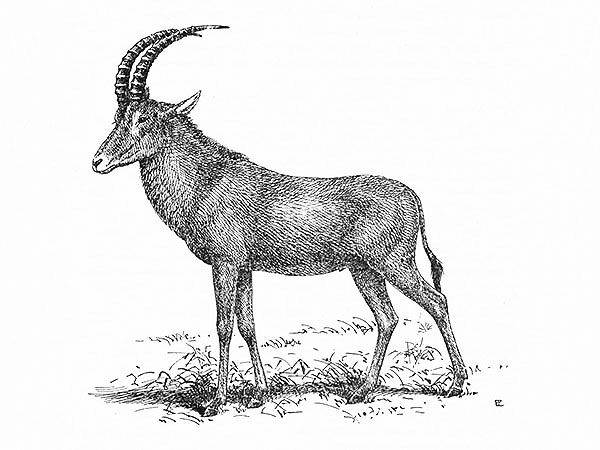
Depiction from: ‘Francis Harper: Extinct and Vanishing Mammals of the Old World. New York, American Committee for international wildlife protection. Special Publication No. 12. 1945’
(not in copyright)
*********************
edited: 17.05.2022
Erepsia promontorii L. Bolus
Cape Erepsia (Erepsia promontorii)
The little Cape Erepsia was known to occur at three areas on the cape Peninsula, South Africa; one was Cape Point, a cliff at the southern end of the Cape Peninsula, the other two were at the town of Hermanus and at Sea Point, today a densely populated suburban of Cape Town.
The species was last seen in 1950 and is believed to be possibly extinct, howevere, it was found growing in the so-called Hangklip Sand Fynbos, a habitat that still exists at least at Cape Point, thus there is still some hope that this species might be rediscovered some day.
*********************
edited: 09.09.2019
Leucadendron spirale (Salisb. ex Knight) I. Williams
Wolseley Conebush (Leucadendron spirale)
The Wolseley Conebush was described in 1809; it was restricted to a small area in the Lower Breede River Valley in the Western Cape Province, South Africa.
The species was last seen in 1933 and is now considered extinct.
*********************
edited: 17.02.2024
Willdenowia affinis Pillans
Table Mountain Willdenowia (Willdenowia affinis)
This species is known from the type material only which was collected in 1918 from the northern slopes of the Table Mountain near Cape Town in the Western Cape province of South Africa.
The area in which this plant was found is now overgrown by alien plants and the species was never found since the collection of the type and is thus most likely extinct. [1]
*********************
References:
[1] N. A. Helme; T. H. Trinder-Smith: The endemic flora of the cape Peninsula, South africa. South African Journal of Botany 72: 205-210. 2005
*********************
edited: 26.04.2021
Felicia annectens (Harv.) Grau
Annexing Cape Daisy (Felicia annectens)
This species, described in 1865, was only ever known from four localities on the Cape Peninsula of southern South Africa.
Annexing Cape Daisy was an annual, up to 15 cm tall, branched or unbranched delicate herb with about 2 cm long and 0.4 cm wide leaves, it had flower stalks up to 6 cm long with blue flowers.
The species, whose taxonomical status is somewhat questionable, is most closely related to the Cape Daisy (Felicia bergeriana (Spreng.) O. Hoffm.) (see photo below); it was apparently last recorded in 1915 and is thought to be extinct.
*********************
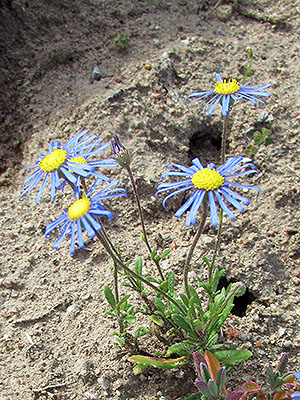
Photo: Chris Vynbos
https://www.inaturalist.org/people/vynbos
https://creativecommons.org/licenses/by-sa/4.0/
*********************
edited: 15.01.2024
Xysmalobium baurii N. E. Br.
Baur’s Xysmalobium (Xysmalobium baurii)
Baur’s Xysmalobium was described in 1907, it is known from a single collection that was made in 1890 where today is the city of Bizana in the Eastern Cape Province of South Africa.
The former habitat of the species is now transformed for subsistence agriculture or is severely overgrazed or otherwise destroyed, it was never relocated since its description and is therefore considered extinct.
*********************
edited: 16.05.2019
Osteospermum hirsutum Thunb.
Hirsute African Daisy (Osteospermum hirsutum)
This species comes from South Africa, more precisely from the region in which today Cape Town is located; it disappeared around 1800 due to increasing urbanization.
*********************
References:
[1] N. A. Helme; T. H. Trinder-Smith: The endemic flora of the Cape Peninsula, South Africa. South African Journal of Botany, Vol. 72(2): 205-210. 2006
*********************
edited: 30.04.2021
Aspalathus variegata Eckl. & Zeyh.
The Variegated Aspalathus was described in 1836; it was endemic to a small locality on the Cape Flats in southwestern South Africa, a area that now is taken by the city of Cape Town.
The species was last found in 1898 and is now extinct.
*********************
References:
[1] N. A. Helme; T. H. Trinder-Smith: The endemic flora of the cape Peninsula, South Africa. South African Journal of Botany 72: 205-210. 2005
*********************
edited: 14.11.2021
Alepidea multisecta B. L. Burtt
Slit-leaved Alepidea (Alepidea multisecta)
The slit-leaved Alepidea is only known from the type material that was collected in 1910 at Gaika’s Kop, a 1963 m high, isolated elevation in the Amathole Mountains in the South African Eastern Cape Province.
Various searches for the species have failed and it must be considered likely extinct.
*********************
edited: 30.04.2021
Erica pyramidalis Aiton
Pyramid Heath (Erica pyramidalis)
The Pyramid Heath was restricted to what today is the city of Cape Town in the Western Cape Province, South Africa.
The species disappeared at the beginning of the 20th century due to the destruction of its habitat by the expanding city, and, despite the fact that the species was even cultivated for some time it is now considered extinct. [1]
*********************
References:
[1] N. A. Helme; T. H. Trinder-Smith: The endemic flora of the Cape Peninsula, South africa. South African Journal of Botany 72: 205-210. 2005
*********************
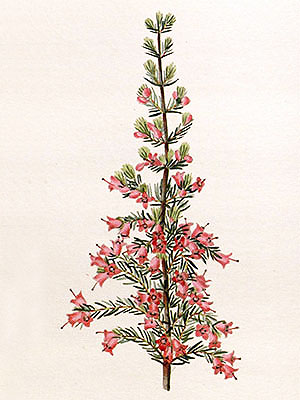
(public domain)
*********************
edited: 18.05.2019
Disa ecalcarata (G. J. Lewis) H. P. Linder
Spurless Disa (Disa ecalcarata)
This species is known only from the type material which was collected in 1947 at an unspecified location on the Cape Peninsula, South Africa.
The species was never found again and is considered extinct, it might, however, be a hybrid or an aberrant form of another species.
*********************
edited: 15.05.2021
Disa forcipata Schltr.
Forceps-shaped Disa (Disa forcipata)
This species is known from the type alone, which was collected in 1870 at an unknown place probably in the Knysna area of the Western Cape Province, South Africa.
The species was never found again and is considered extinct.
*********************
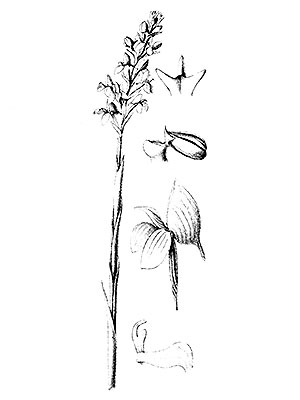
(public domain)
*********************
edited: 15.05.2021
Acilacris furcatus Naskrecki
The Mount Coke False Shieldback was described in 1996 based on specimens that had been collected in 1965; the species was restricted to a single, small locality in the Eastern Cape Province, South Africa.
The species was not found since its discovery and might be extinct.
*********************
edited: 17.11.2021
Algophilus lathridoides Zimmerman
Table Mountain Crawling Water Beetle (Algophilus lathridoides)
The Table Mountain Crawling Water Beetle, described in the year 1924, is known only from the type locality near Simons Town in the Western Cape Province of South Africa.
The species was obviously not found during recent field searches and is considered most probably extinct.
*********************
References:
[1] T. R. New: Beetle Conservation. Springer 2007
[2] A. G. Rebelo; P. M. Holmes; C. Dorse; J. Wood: Impacts of urbanization in a biodiversity hotspot: Conservation challenges in Metropolitan Cape Town. South African Journal of Botany 77: 20-35. 2011
*********************
edited: 01.11.2020
Hesperantha saldanhae Goldblatt
Vredenburg Hesperantha (Hesperantha saldanhae)
This species is known exclusively from the type collection from 1964.
The Vredenburg Hesperantha was found on granite rocks, which are located at the edge of the town of Vredenburg in the Western Cape Province, South Africa.
The species was never found since and is considered most likely extinct.
***
The photo shows one of the many beautiful species of this genus, the Red Hesperantha (Hesperantha coccinea ((Backh. & Harv.) Goldblatt & J. C. Manning)).
*********************
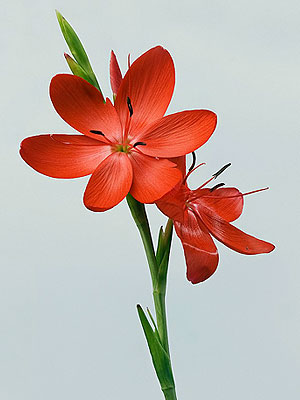
Photo: J. J. Harrison
(under creative commons license (3.0))
http://creativecommons.org/licenses/by-sa/3.0
*********************
edited: 07.11.2017
Lepidochrysops methymna ssp. dicksoni Tite
Dickson’s Dark Opal (Lepidochrysops methymna ssp. dicksoni)
The Monkey Blue is widely distributed in the Eastern- and Western Cape Provinces of South Africa, the species has very high demands concerning the structure of its habitat.
The caterpillars in the first few days of their life feed on two plant species, Pseudoselago serrata (P. J. Bergius) Hilliard and Pseudoselago spuria (L.) Hilliard, hereafter they require the presence of colonies of a special ant species, Liengme’s Camponotus Ant (Camponotus liengmei For.) (or Camponotus maculatus ssp. liengmei For.), in whose anthills they live from the third instar on as brood parasites, feeding on the eggs and larvae of the ants.
***
Dickson’s Monkey Blue, called Tygerberg-bloutjie in Afrikaans, was described in the year 1964. The subspecies was restricted to a very tiny area of only about 4 km² on the northwestern side of the Tygerberg range – this area was converted into agricultural land for wheat farming, whereby both, the food plants as well as the ant colonies were destroyed.
Dickson’s Monkey Blue is now considered extinct.
*********************
References:
[1] G. A. Henning; R. F. Terblanche; J. B. Ball: South African Red Data Book: butterflies. SANBI Biodiversity Series 13. South African National Biodiversity Institute, Pretoria 2009
*********************
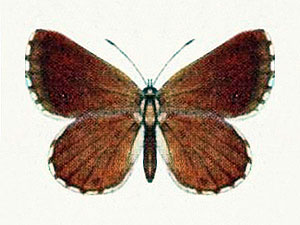
(public domain)
*********************
edited: 14.10.2016
Holothrix culveri Bolus
Culver‘s Holothrix (Holothrix culveri)
Culver’s Holothrix, described in 1905, is a very inconspicuous orchid species that is known exclusively from the type collection, originating from 1890.
The type locality is located close to what today is the town of Barberton in the Mpumalanga Province of South Africa, and is now completely destroyed by a road that was built right across the site, the habitat is heavily degraded due to spread of informal settlements.
Thus, the species is considered most likely extinct. However, search operations undertaken repeatedly between 2002 and 2006 produced the finding of at least one plant that may be this species, yet there is only this single plant, and its identity has obviously not been confirmed ever since.
*********************

(public domain)
*********************
edited: 20.03.2018
Riocreuxia woodii N. E. Br.
Wood’s Riocreuxia (Riocreuxia woodii)
This species, described in 1908, was endemic to KwaZulu-Natal, South Africa.
The species was a climbing plant with heart-shaped leaves and lantern-shaped flowers.
*********************
edited: 31.10.2017
Leucadendron grandiflorum (Salisb.) R. Br.
Wynberg Conebush (Leucadendron grandiflorum)
The Wynberg Conebush obviously was described on the basis of a drawing, made from a plant grown in Great Britain, to where it was imported as a garden plant around 1809.
The only information about the species we have today is that it originated from a place called Wynberg, which today is a southern suburb of the city of Cape Town in Western Cape, South Africa.
The Wynberg Conebush disappeared around about 1800, when its habitat was destroyed due to urbanization. [1]
*********************
References:
[1] N. A. Helme; T. H. Trinder-Smith: The endemic flora of the Cape Peninsula, South Africa. South African Journal of Botany, Vol. 72(2): 205-210. 2006
*********************
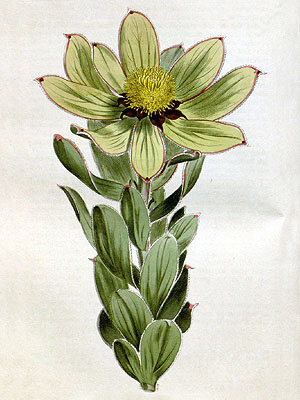
(public domain)
*********************
edited: 03.11.2020
